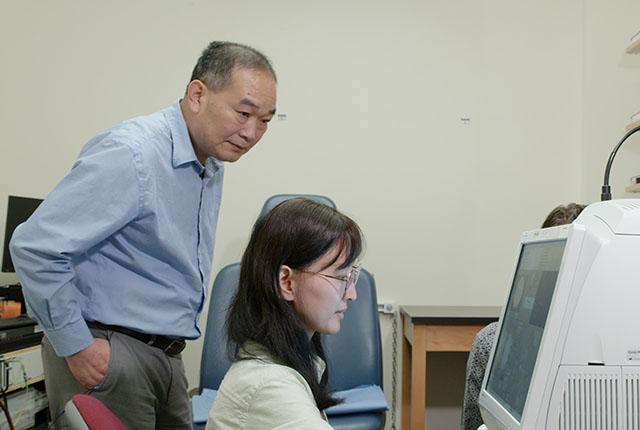
Inventor’s pursuit: How smartphones can better your health
Ricky Wang, who modernized the way clinicians check your vision, has set his sights on turning your phone into a medical multitool.Media Contact: Chris Talbott - talbottc@uw.edu, 206-543-7129

Ruikang “Ricky” Wang applies a very simple mantra to the complex work done in his Biophotonics and Imaging Laboratory.
“Our aim in the lab is really to help the healthcare system, particularly in low-resource settings,” he said.
To that end, more than a decade ago, the University of Washington School of Medicine professor invented a technique called optical microangiography that revolutionized eye exams. The technique made it easier and cheaper for millions of people around the globe to receive top-tier vision care — especially in parts of the world where such care was previously out of reach.
Flash forward to today: Wang and his students are using smartphones to make advances in ways that might seem more science fiction than modern medicine. It turns out your selfie-taking, music-playing cell phone can also help determine your risk for stroke, mind your dental health and red-flag potentially troublesome skin spots, among many other applications.
Related video: Ricky Wang discusses smartphones and health
Wang will receive UW Medicine’s Inventor of the Year Award at a ceremony Nov. 1. The award recognizes outstanding UW scientists whose inventions have had a major impact on human health and the local economy.
Wang’s story is as interesting as his work. Born in China, he studied for his doctorate in Scotland and was a professor at Cranfield University in England before coming to the United States. He’s now a UW School of Medicine professor of bioengineering and of ophthalmology and holds the George and Martina Kren Endowed Chair in Ophthalmology Research. Bioengineering is a joint department with the College of Engineering.
Wang’s invention of optical microangiography, also known as optical coherence tomography angiography, or OCTA, shrank the technology necessary to inspect the small, vulnerable blood vessels in the eye. These cheaper, smaller versions are also portable and have become ubiquitous globally.
Wang has a similar goal for his cell phone advances. The underlying technology is like a very large toolbox, and Wang and colleagues are just starting to dig into the possibilities.
“Everybody has the smartphone in their pocket, right?” Wang said. “So, how can we power this smartphone to help human health?”
The power of the smartphone starts with its ability to take high quality photos, he said. There’s far more information in the photo than the human eye can process, and Wang uses the smartphone’s own computing power to analyze that information.
In one application, he uses light to spot signs of tooth decay. The photo shows areas under attack by bacteria that can’t be seen with the naked eye. In another, pictures of suspect areas of skin are analyzed for signs of cancer. He can also analyze images of a face and scan for the likelihood of stroke based on blood flow in the region of the forehead between the eyes.
Wang only recently turned to smartphone research in his lab. But after a few years of exploring the possibilities, he thinks the cell phone will revolutionize medicine, putting tools in the hands of people who need help the most.
“For example, there's a device called a hyperspectral imaging camera,” Wang said of a machine that analyzes the color spectrum of pixel images. “And that device costs more than $1,000 to buy. Instead, here (in my lab), we try to utilize the smartphone to do the same because the smartphone is in almost everybody's pocket.”
Learn more in these broadcast-ready video soundbites.
For details about UW Medicine, please visit https://uwmedicine.org/about.